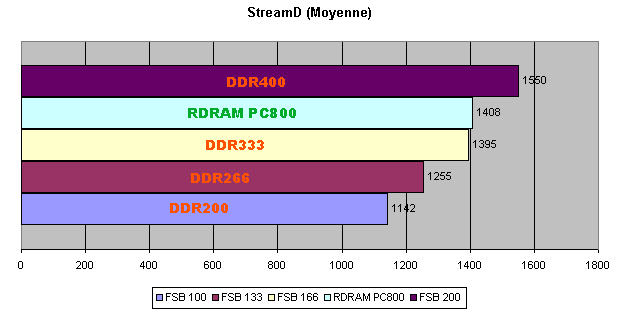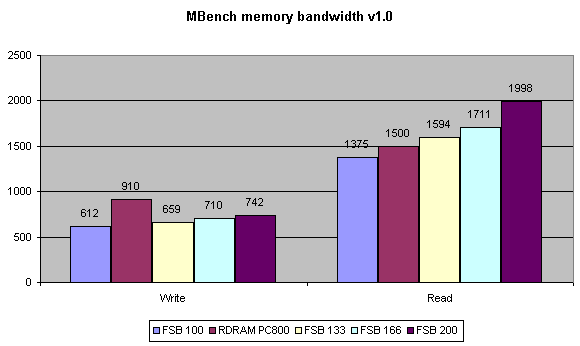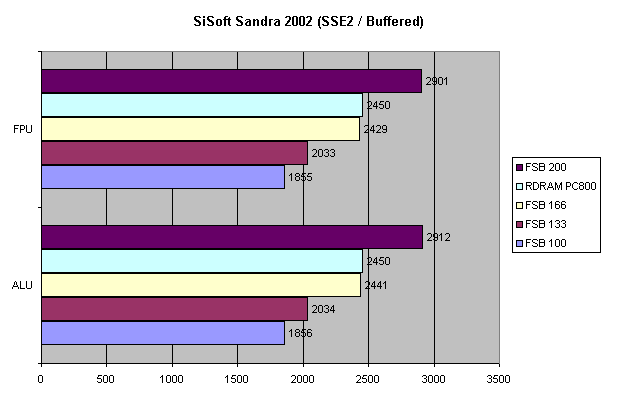
| Summary : |
![]()
[Intel] Synchronous Benchmark results
Regarding the testings in synchronous mode on the Intel platform, we did not wish to spent a lot of time on this specific test, and this for the following reasons :
- first of all because of the fact that a 200MHz on an i845D could not run 100% stable even with increasing the Voltage up to 2V
- second because of the fact that a 200MHz bus in a QDR environment equals to a data troughput of 6.4Gb/S, wich is the double of the theoretical limit of 3.2Gb/S for a DDR400
- and finally because this CPU "Engineering Sample" is extremly rare and difficult to find, and that even for the most fanatic overclocker, it's totally utopic to try to find one.
Anyway we did our test with StreamD, Mbench and Sandra 2002 under following
conditions (for a precise description of these softwares we refer to the
detailled information available on the AMD testing page) :
- Bus 100 Mhz (400 QDR) or DDR200 (PC1600) - Coefficient 20x => 2000 Mhz
- Bus 133 Mhz (533 QDR) or DDR266 (PC2100) - Coefficient 15x => 2000 Mhz
- Bus 166 Mhz (666 QDR) or DDR333 (PC2700) - Coefficient 12x => 2000 Mhz
- Bus 200 Mhz (800 QDR) or DDR400 (PC3200) - Coefficient 10x => 2000 Mhz
-= StreamD =-
Regarding the testing results we obtained with StreamD, we will not detail every single part of the test (Copy, Scale, Sum and Triad) but we will use the average values obtained in these three testing programs. Here the results :

It's maybe boring to tell, but once more we are extremly impressed with the results. The PC800 Rambus wich was still competive in front of the DDR333, lost once more also in this benchmark test, let's check immediatly with Mbanch to see if this one confirms those testresults.
-= MBench =-
The test results with Mbench are a little bit different compared to previous Benchmarks :

Here we notice that in Read mode, the Rambus can't compete with any DDR-SDRAM as off the PC2100, but if you check the Write mode the results are totally oposit, even with a 200MHz FSB.
Let's take a look at the module latencies :
|
FSB
|
Latence (en ns)
|
| 100 Mhz RAMBUS |
171
|
| 100 Mhz DDR |
152.1
|
| 133 Mhz DDR |
139.3
|
| 166 Mhz DDR |
122
|
| 200 Mhz DDR |
108.9
|
Due to the operationnal features the Rambus latency is much higher than
what we encountered on a DDR-SDRAM, on the DDR400 the latency even dropped
at a 109nS, wich can really be considered as an exceptionnal value for
a Pentium 4 platform.
-= SiSoft Sandra 2002
=-
The same results were obtained with Sandra, also here we noticed that the RDRAM allmost equals the performance of a DDR333, but has no chance to get close to the DDR400 performance. Those facts make us understanding why Rambus is in a hurry to release his PC1066 RDRAM, this might probably be the only issue for Rambus to stay in the top-performance arena, and certainly if competion brings his DDR400 into the market :

2.9GB/s !!! We are very close to the theoretical maximum troughput of 3.2GB/S !
Finally if you compare these results with the currently used DDR266,
the DDR400 offers really superior performance. It's clear to us, the future
of our memories is already here, and this even before we swapped to even
more powerfull versions like the DDR-II, which will offer twice the DDR-I
performance. But this type of technology is still under developpement
at the world leading manufacturers. So let's take a look, at all the benefit
you can have with a Kingmax DDR400, without needing to source some priviledged
material or equipment, but only based on an easy to source hardware configuration.